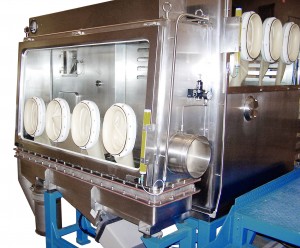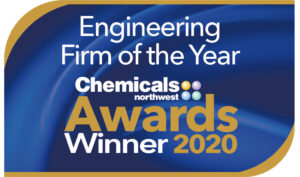
An Engineered Solution to Recover and Re-Process Uranium Dioxide
PROBLEM
Hosokawa Micron Ltd was asked to provide an engineered solution to recover and re-process Uranium Dioxide, stored for over 20 years in 25 gallon steel drums. The UO2 was originally recovered as part of a decommissioning project and is heavily contaminated with construction and building debris.
The steel drums contain varying levels of contaminants, but the exact contents of the drums are un-known and cannot be established until each drum is de-lidded and visually inspected. The condition of the drums is generally deteriorating over time and a solution was required to establish the contents of the drums, empty the drums, and process the recovered nuclear material.
WASTE RECOVERY AND PROCESSING SYSTEM SOLUTION
Stage 1: Drum Handling
The drum is loaded into the Glovebox transfer chamber where the operator removes the drum lid using the gloveports and carries out an initial visual inspection of the contents. The inner, powered transfer door is opened and the drum moves into the tipper cradle inside the main chamber of the Glovebox.
Using external controls the operator then tips the drum and the contents fall out of the drum into the base of the Glovebox.

Stage 2, Waste Sorting
Through the gloves, the operator manually sorts the waste material and separates pieces of UO2 from the other waste which could include bricks, nuts & bolts, concrete etc. Rejected waste material is passed into the waste chute. Uranium Dioxide pieces are fed into the re-processing chute using the vibratory feeding system integrated in the Glovebox base.
Stage 3, Size Reduction
Fed via a re-processing chute the UO2 enters the first size reduction stage which incorporates a re-engineered, low through-life maintenance, Hosokawa Hammer Mill with swinging hammers.
The second stage of size reduction also uses a Hosokawa hammer mill but with a finer screen to ensure that the discharged processed powder is within the required particle size distribution parameters.
Stage 4, Powder Collection
The powder is collected in SGCs (Safe Geometry Containers). The SGC is loaded into the lower Glovebox transfer chamber and de-lidded by the operator and transferred into the lower Glovebox main chamber.
The filling pipe and filling cone inlet are sealed together and a local extraction ring removes any dust released during the un-docking of the filling head.
The filled SGC is transported back into the transfer chamber, re-lidded and removed from the containment.
Stage 5, Powder Feeding
The SGC is loaded into the transfer chamber of the powder feeder Glovebox and de-lidded by the operator. Powder is fed into a buffer hopper via a rotary valve and metered into the acid dissolver using a loss in weight vibratory feeder.
CONCLUSION
The size reduction of waste material can be carried out either as part of a recovery & re-processing system, or to reduce the overall volume of waste for more efficient & lower cost storage.
The Hosokawa Micron system described above was installed at a nuclear fuel manufacturing facility and although the exact content of each drum is not known, the plant records were used to demonstrate that the level of containment provided was suitable for the potential risk of operator exposure to the contents.
Due to the bespoke nature of the Hosokawa Micron Ltd system, it could be adapted to provide containment and processing of other nuclear materials and could incorporate a higher level shielding or remote handling systems to handle higher hazard waste materials.



